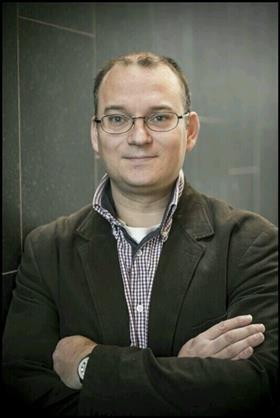Defining the future of the chemical industry is a good start, but realizing these visions will prove challenging. We asked Bas de Bruin, Guido Mul and Atsushi Urakawa, all of them PIs within ARC CBBC, to share their ideas on how we can turn that envisioned future into reality.
‘Politics, economics and technology are all needed to get to a truly sustainable chemical industry’
Atsushi Urakawa, Professor of Catalysis Engineering at Delft University of Technology

‘Realizing the Refinery of the Future involves different aspects. In my group, we are working on CO2 conversion catalysis, and we have developed a very efficient process for producing methanol from CO2. Being a C1 feedstock, methanol is a key building block for the chemical industry that can be turned into a wide range of products but is also useful as a chemical fuel and a hydrogen storage compound. Of all the projects we are working on, this technology is closest to commercialization, but there are plenty of practical challenges that are way beyond the reach of academia.
If we really want to implement these technologies for carbon management, we need more than just fascinating, beautiful new technologies. We also need political support, we need to have the right policies – like a carbon tax and an accommodating definition of green fuels – in place, and we need to the economics of it all to make sense.
Besides methanol, another obvious attractive chemical energy carrier is SAF, sustainable aviation fuel. Production of these chemical fuels from CO2 requires hydrogen which is now the major cost driver. At present, using CO2 hydrogenation approaches, 60-70% of the overall cost is related to hydrogen production, for example, by water electrolysis. Clearly, we need cheap hydrogen. Which on its part requires cheap renewable electricity as the key.
Electricity costs should come down drastically. That is why we not only need technological innovation, but also the correct alignment of political and economic perspectives. Politics, economics and technology, in addition to international cooperation and a strategy to optimize where to produce renewable energy and where to produce chemicals, are all needed to get to a truly sustainable chemical industry.
From a technological point of view, all options are available. But as long as the economic feasibility depends on volatile markets for hydrogen and, consequently for methanol, ammonia etc., then we won’t make progress. If the economy doesn’t make sense, we will not be able to capitalize on the potential of these new technologies.
We need to make politicians aware, but I see serious challenges in the communication between politicians and chemists and engineers. Industry does suffer too, but it has its lobby in place to some extent, while academia doesn’t. It is important we academics explain to politicians that we really want to do relevant research, create impact and implement our technologies and what we need from them. We should be able to do this; after all, we are all teachers, we train our students and are skilled in didactics. There is a strong momentum now and the Netherlands has a track record of good industry-academia relations to understand the mutual interests and define technological and societal goals towards sustainable development. The challenge however is that we lack a clear path for academia to operate towards implementation.’
‘Paired electrolysis allows production of useful compounds at both electrodes’
Guido Mul, Professor of Photocatalytic Synthesis at the University of Twente

‘The key question when considering our route towards the refinery of the future concerns the supply of carbon. Of the four elements that we need the most in chemical processes, being carbon, hydrogen, oxygen and nitrogen, we can source the last three out of water and air, but where do we get the carbon from once we stop using crude oil and natural gas? There are three predominant options: plastic waste, biomass and CO2. Within ARC CBBC, we participate in the multilateral project “New chemistry for a sustainable future” and here, we focus on the third option: using CO2 as a feedstock.
Through electrochemical reduction, you can release the C out of CO2 and that line of research has expanded immensely over the past years. Even so, there is still a lot of work to be done before we can deploy the large-scale electrochemical conversion of CO2 in a competitive manner. One of the problems is that you’re dealing with a three-phase process in the electrolyser: a gas phase (CO2), a liquid phase (water), and a solid phase (electrodes).
Copper is the material of choice for the electrodes, but it is not stable in most applied experimental conditions. When the reaction progresses, copper ions will dissolve, which changes the performance of the electrode. A major technological challenge is to ensure optimal contact of CO2 and the catalytic surface and to this end, we employ so-called porous gas-diffusion electrodes. But it is very difficult to maintain a constant interface between the gas and liquid phases to prevent “flooding”; when water infiltrates the porous electrode, leading to less available catalytic surface for CO2 to react and allowing the competing production of hydrogen.
But that is just one part of the story. The other challenge is to make this whole process economically viable and therefore we are also concentrating on the reactions taking place at the anode, where oxygen is produced. As there is no relevant market for oxygen, we are developing a concept known as “paired electrolysis” in which useful compounds are produced at both electrodes.
One of the possibilities we are pursuing is the selective oxidation of short alkenes like ethylene and propylene, to produce epoxides. Particularly for propylene-oxide this may offer an interesting route as current catalytic processes are indirect and inefficient, whereas there is serious demand for propylene-oxide as a solvent or a feedstock for polymers. In our set-up, using organometallic complexes such as silver pyridines as catalysts, we could produce propylene-oxide, but also ethylene-oxide from ethylene, all in one reactor starting from CO2. If we can make this work, we are realizing important steps forward in both the feedstock and the energy transition.
Of course, this requires access to cheap, “green” electrons, which are becoming the energy input of the future. And that raises other questions. Will we let ourselves become dependent on the electricity supply from other areas that have a competitive advantage, for example the Middle East? Or will we take the necessary steps here to secure affordable electricity?’
‘I think many people underestimate the amount of work that is still ahead of us’
Bas de Bruin, Professor of Bio-inspired Sustainable Catalysis at the University of Amsterdam

‘Establishing a more sustainable chemical industry implies that we move away from fossil feedstocks and start using other sources, like biomass or CO2. But it will require much more than just replacing the feedstocks. We should also replace the current expensive, rare metal catalysts with cheaper, more available materials. And if we really want to create more sustainable production processes, meaning that we aim for more efficient processes with fewer unwanted side reactions and less waste, we have to replace the current thermal chemistry with electrochemistry and photochemistry. But that is more easily said than done.
I think many people underestimate the amount of work that is still ahead of us. It is easy to assume that everything has already been invented and that we just have to implement it, but if we are changing the starting materials and changing the way we do chemistry and changing the catalysts, then we will also have to re-invent and re-optimize all those chemical reactions and processes. Let’s not forget that it took decades of research and optimization for the fossil-based chemical industry to become as efficient as it is today.
One clear challenge that we have to tackle concerns controlling radical chemistry. When we use electrochemistry and photocatalysis for synthesis, we are moving into radical chemistry and how can we control those reactions using a transition metal catalyst? How do we design and develop catalysts that are able to deliver the desired products without letting this whole high energy system filled with radical intermediates run of out control and plunge into a deep thermodynamic well?
We need much more understanding of metallo-radical chemistry and photo-redox chemistry before we can make this work. And there is the problem of creating electrodes that last much longer than they do now. Or the electrolyte, how do we separate that from the products in an efficient way?
Electrification of the industry implies not only changing the way the reactors are heated, even though that would also have great impact, but it is also about developing completely new ways to create the products we need. We are now starting up the plans for work packages 5 and 6 of the “Groenvermogen” programme, which focus on efficient photo- and electrocatalysis. I’m very curious to learn what questions all partners, especially from industry, will propose.’
















Nog geen opmerkingen